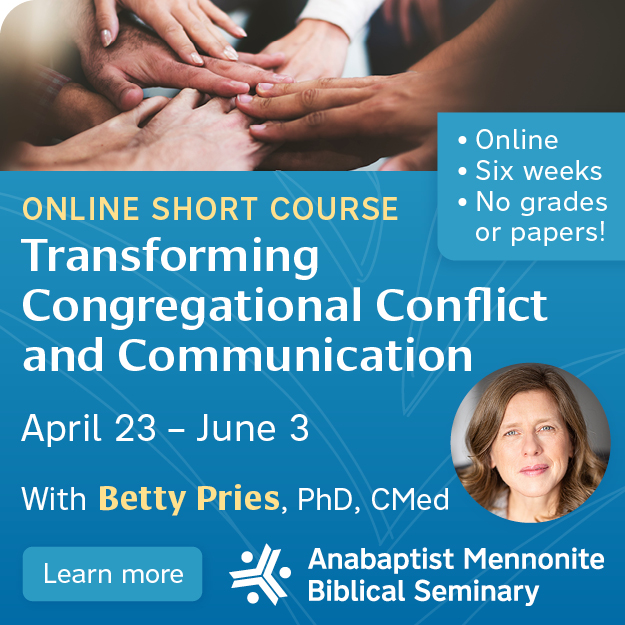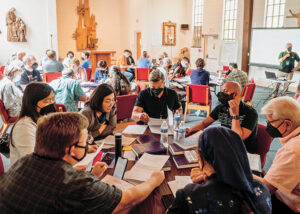In late September 2015, many of us were enthralled by a rare celestial display: a super moon in total eclipse, also known as a blood moon because of its reddish glow—clearly a reference to the apocalyptic vision from Revelation 6.
I talked about the blood moon on the phone with my 93-year-old mother, who said, “Oh Sara, I remember a night in Ethiopia, when you were a little girl. The night watchman woke us all in a panic, banging on our bedroom window, crying: “The moon burned up! The moon burned up!”
Imagine the panic of someone with a pre-scientific world view, someone with no concept of eclipses, watching the moon devoured, engulfed in a red haze of flames.
In early October, Anabaptist Mennonite Biblical Seminary (AMBS) hosted its second Rooted & Grounded conference on land and Christian discipleship. There was graphic apocalyptic talk there, not among pre-literate night watchmen, but among scholars, theologians, and scientists. Ched Myers, activist theologian, biblical scholar, leading voice in an ecological movement for watershed discipleship, spoke of the four horsemen of the apocalypse. The white, red and black horses and their riders appear in Revelation, bringing war and economic disaster upon the earth. And then there is a pale green horse—whose rider is named Death. What follows in his wake is ecological catastrophe.
Rapacious greed is bringing today’s world to the brink of unprecedented catastrophe. Ecological stresses exacerbate violent conflicts, unprecedented migration, religious extremism, racist bigotry and poverty. There are reasons to be alarmed.
My intention here isn’t to discuss climate change or the apocalypse. But I use this pairing of biblical mystical images with a scientifically informed world view to suggest where I think the most urgent work lies for Anabaptist Mennonite schools.
What I want more than anything for our schools is that, as communities of learners, we come alive to the wondrous love that vitalized this world into being; that we with poet Gerard Manley Hopkins ask—“What is all this juice and all this joy”?
I believe it is only out of a wellspring of vitalized love that our graduates can unflinchingly face the brutal facts and go toward the devastation. It is only out of a wellspring of vitalized love that our graduates will become beautiful messengers who announce peace and salvation.
What most animated the Anabaptist movement was their rediscovery of God’s down-to-earth salvation story, especially the stories of Jesus. This rediscovery galvanized them to break with the worn-out status quo of their time. This rediscovery alerted them to see how the dominate culture had domesticated the gospel. The rediscovery of the world-transforming visions of the Bible awakened them to the joy of God’s Jubilee gospel, and they became part of a spirited movement to awaken hope in their anguished communities.
How might our Anabaptist Mennonite schools inseparably hold together an immersion in the gospel of our resurrected Lord with an immersion in communities of persons who are victimized by the ruling powers? How might we hold together an immersion in the world-transforming visions of the Bible with an immersion in the natural world, the sciences, humanities and professional studies? How might a new awakening to the mystical biblical visions of the world-as-it-should-be ignite fierce love to save the real world right under our feet?
I set up a horrific pairing of the images of the four horsemen with current scientific projections of cataclysm on the earth. A beautiful contrast image is the prophet Ezekiel’s vision in chapter 47:1-12 of water rehydrating the land and fruitful trees whose leaves are for the healing of the nations, an image that reappears some 700 years later to John the Revelator—recorded in the final chapter of Revelation.
O Lord, what an image! What a beautiful, verdant image. Ezekiel was a prophet among a people in exile; a people of the land who had seen its devastation; a traumatized people who had been violently forced to migrate.
What is remarkable about Ezekiel’s vision is that the life-giving water flows not from the king’s palace but from the Lord’s temple. The cleansing river flows not from the conqueror’s throne but from the sanctuary of a worshiping community in touch with the “juice and joy” of God’s reign.
The water begins with a trickle and grows into a vast river that restores fertility to the dry lands. Stagnant waters become fresh, and everything lives where the river goes—every living creature, swarms of fish and all kinds of trees that bear fresh fruit every month, because the water flows from the sanctuary. The leaves of the trees are for healing.
What might exemplify this life-giving water flowing from the sanctuary in our day? How might immersion in biblical mystical visions of God’s love for the world vitalize our graduates to be about God’s saving mission in the world?
From what I observe, a lot of us have become deeply ambivalent about the Bible. The Bible is a battleground on which the culture wars are fought. Our church is being pulled apart because of wrongheaded ways of reading and interpreting the Bible. The revitalizing potency of the Scriptures that so transformed our Anabaptist forebears and so many other courageous folks is lost on us because we’ve formed oppositional defensive positions in the culture wars.
On the one hand there’s a resurgence of science denial, of anti-intellectualism that claims biblical justification. People attack our schools because we welcome our students to ask tough questions and we encourage faculty to discern more honest ways to interpret the Bible. An idolatry of the Bible, dressed up in bogus theology and self-righteous bigotry is driving scores of gifted, bright young people from the church.
On the other hand, closer home, those of us in higher education in particular, can exude a kind of intellectual sophistication and ethical superiority, with a near disdain for the Bible and expressions of heartfelt faith.
Rather than turning the Bible into a battleground to be severely used by some and belittled by others, how might we help our students comprehend the goodness of the gospel, precisely because we take them to uncomfortable places of fracture, oppression, and devastation?
How might our schools prepare students to become resilient social scientists, church planters, physicians, historians, peacemakers, literary artists, and teachers by becoming centers of revitalizing meditation on the Scriptures in worship, creative visualization, prayer and study?
How might our schools lead with a faith orientation that is conservative in that we unapologetically root our faith in an ancient, wise tradition? And progressive in that we lead with an innovative, justice-seeking theological vision like Jesus and the Anabaptists?
The reality on the ground is brutal; yes, frightening in the extreme. The apocalyptic horsemen are out and about with a vengeance. There is every reason to believe that the children, youth and young adults in our schools will face the most daunting challenges of any generation—particularly if they walk toward the trouble.
We need nothing less than another great awakening, a spiritual awakening to fortify the leaders of the new generation with the strongest brew of wondrous, strong, vitalizing love imaginable.
May our Anabaptist Mennonite schools be in the vanguard of that spiritual awakening:
- An awakening to the earthy, mystical visions of the Bible that take us with new fervor into the science lab and local water shed.
- An awakening to the potency of biblical cries for justice that put moral verve in our professional practice and leadership.
- An awakening to the irrepressible Spirit still vitalizing God’s people to go into all the world with Jesus’ down-to-earth salvation story.
The leaves of the trees healing the nations—may it be so with our schools.
This reflection is based on Sara Wenger Shenk’s concluding sermonic plenary for Bluffton University’s Mennonite Education conference, Mennonite Education: Past Present and Future, at the worship service on October 18, 2015. To listen to Sara’s 21-min. sermon, start at 38:15 of this recording: “Leaves of the Trees Healing the Nation.”








Leave a Reply
You must be logged in to post a comment.